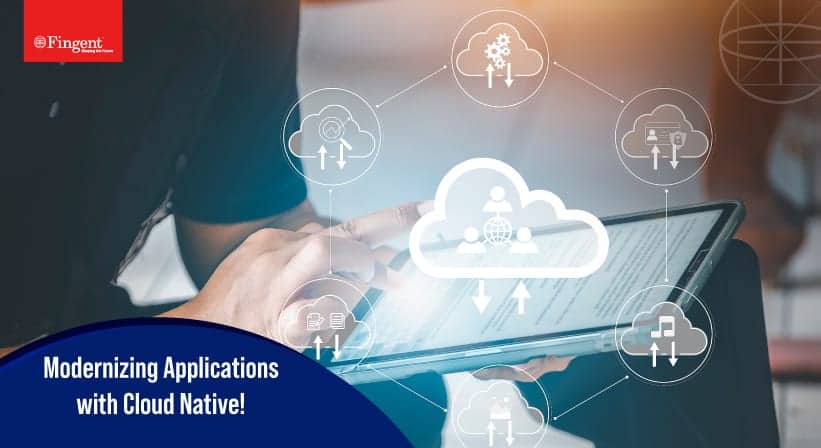Cloud-Native Application Development: How It’s Powering App Delivery!
Applications are at the front and center of business strategy today. Software-driven business transformation requires new apps that can be developed and delivered faster. Organizations need a new platform to support these changes – one that can deliver high-quality apps.
Globally, cloud platforms are redefining the way enterprises scale their businesses. Enterprises are under tremendous pressure to develop and deploy applications faster and more efficiently. Cloud-native applications help tech-savvy enterprises stay ahead of the competition.
Today, cloud-native application development has emerged as an innovative concept. It has altered the way software applications are developed, shipped, and managed. This article discusses in detail what cloud-native application development is. It will also explain how cloud-native application development is empowering app delivery.
What Is Cloud-Native Application Development?
A cloud-native application is designed for cloud computing architecture. These applications are built and hosted in the cloud. Cloud-native application development is an approach that exploits the flexibility, scalability, and resilience of cloud computing. It includes various tools and techniques used by software developers to build applications for the public cloud.
Cloud-native takes full advantage of the cloud computing model. Therefore, it efficiently combines architecture and technology that enable the design, development, and operation of workloads in the cloud. Cloud-native application development empowers you to gain a competitive advantage by quickly bringing ideas to market.
Cloud-native applications have shorter application lifecycles and are highly resilient, manageable, and observable. They speed up the development of new applications, optimize existing ones while connecting all of them.
Cloud-native application development is mostly based on microservices. Microservices are discrete and reusable components that can be used in any cloud environment. It is a multidimensional approach. It represents a cycle where complete focus is on the journey rather than the destination. Hence, it is all about building new applications and modernizing the existing ones on the principles of the cloud.
Read more: A Comprehensive Guide To Modern Cloud Application Development

What Is Cloud-Native Architecture and How It Empowers App Delivery?
Cloud-native follows five architectural features. These features are microservices, APIs (application programming interfaces, containers, backing services, modern design. These help businesses ship products faster, implement their customer’s needs, create value quicker, and aid collaboration between developers and IT specialists. Let’s consider each of them:
1. Microservices
It becomes easier to scale when a monolithic application is broken into many smaller pieces. These pieces are called microservices. Each of these microservices is designed to be autonomous, independent, and self-contained.
This approach is advantageous as each microservice can be deployed, upgraded, scaled, and restarted: without impacting the end-user. Microservices are independent and so you can eliminate dependencies and coordination efforts. The teams can work parallelly, thereby increasing velocity. Microservices enable elasticity-a key attribute of cloud computing.
2. Containers
Containers are crucial for packaging and running cloud-native applications. Microservices are grouped into container images and deployed onto a host operating system as they are faster and lighter.
Containerization allows the bundling of a cloud-native application into a single unit. This unit may contain libraries, configuration files, or other components that the application needs. The containerization process makes it easy to test, move, and deploy the applications.
Because of its agile nature, you can start or stop a container at a moment’s notice and remove any defective instances. Container system guarantees consistency and increases application portability across cloud systems.
3. Backing services
Cloud-native systems depend on ancillary resources. These resources include data stores, message brokers, monitoring, and identity services. These are called backing services. You could develop them in-house or simply select from a rich assortment of managed backing services offered by vendors. The latter is a better option as it can significantly save you time and labor.
As backing services can be bound dynamically to a microservice, it acts as an attached resource but decoupled from the application and remains interchangeable. In a nutshell, backing services can be attached to and detached from a microservice using a configuration management tool.
4. Application programming interfaces (APIs)
Microservices need an intrinsic mechanism to talk to each other. Plus, Client-facing microservices need to accept and respond to user requests. Application programming interfaces are those software connectors that can send and receive data, metadata, and service requests.
In cloud-native applications, RESTful APIs manage communication between microservices. Furthermore, APIs expose functionality that other software can use. It is a good practice to avoid touching the underlying code. As a best practice, APIs make it is easy to extend or customize applications without disturbing the underlying code.
5. Modern design
Despite having a wide variety of tools and techniques, one cannot avoid all challenges that arise in application development. So, IT teams must develop customized application monitoring and management methods. These methods must suit the organizations’ cloud model and IT infrastructure.
Watch: How InfinCE – A Digital Workplace Orchestration Platform, Can Help you Seamlessly Experience Infinite Cloud For Your Enterprise!
Why Is Cloud-Native Important Now?
Cloud-native is a cost-effective way that brings ideas to market quickly. Here are a few characteristics that make cloud-native critical for business growth:
- Auto-scalability: Cloud-native applications can scale services automatically and independently and do not require daily management.
- Elasticity: These applications and services can scale in-out and up-down as the demand changes ensuring efficient usage of resources.
- Speed of deployment: Businesses receive faster feedback and delivery when continuous delivery and deployment are used. It results in faster shipping of applications.
- Resilience: These services can survive outages and failures and remain online as disaster recovery mechanisms are available in the cloud.
- Cost-effective: As these applications are cloud-based, computing and storage resources can scale as needed. Thus, eliminating the need for overprovisioning. Businesses can use containers to maximize the number of microservices run on the host. It saves time, resources, and money.
- Easy to manage: As cloud-native applications use automation, developers can track all microservices and components as they are updated. The team can focus on a specific microservice without worrying about how it will interact with the other services.
- Visibility: It is easy for the teams to study applications and learn how they function together, as a microservice architecture isolates services.
Read more: Cloud Migration Strategy: 7 Steps To Accomplish A Flawless Transitions

Key Takeaways
Cloud-native application development is here to stay. Businesses will continue to use cloud-native technologies for agility and efficiency benefits. Most importantly, it is a cost-effective way to architect new applications. Businesses must consider the tradeoff between cost, effort, and time involved in moving to a cloud-native architecture.
The transition towards a cloud-based digital-first organization can be hassle-free when you have the right partner to guide you through it. At Fingent, our developers have the experience and know-how to do it right for you.
Give us a call and let’s get talking!
Stay up to date on what's new

Recommended Posts

05 Nov 2023 B2B
Cloud 101 – Getting a Good Return on Your Business Cloud Investment!
In the digital age, cloud investment is your business's propulsion, offering flexibility, scalability, and a competitive edge. However, many companies don't fully reap the cloud's benefits. The cloud's potential remains……

15 Oct 2023 B2B
Hyperscaler Cloud Services: The Next Step In Business Cloud Investment!
Companies can save 20% of the total annual cost if they migrate to the cloud. Hyperscaler Cloud Services can enable businesses to experiment, build, innovate, and run any form of……

30 May 2023 B2B
Cloud Application Development: Empowering Your Business In The Digital Era!
“Cloud computing is really a no-brainer for any start-up because it allows you to test your business plan very quickly for little money. Every start-up, or even a division within……

28 Mar 2023 B2B
Cloud-Native: The Modern Way to Develop Software
For more than a decade, businesses in all industries have undergone a digital metamorphosis. This evolution is marked by a transition from on-premises software solutions to cloud-based computing technology. By……
Featured Blogs
Stay up to date on
what's new













